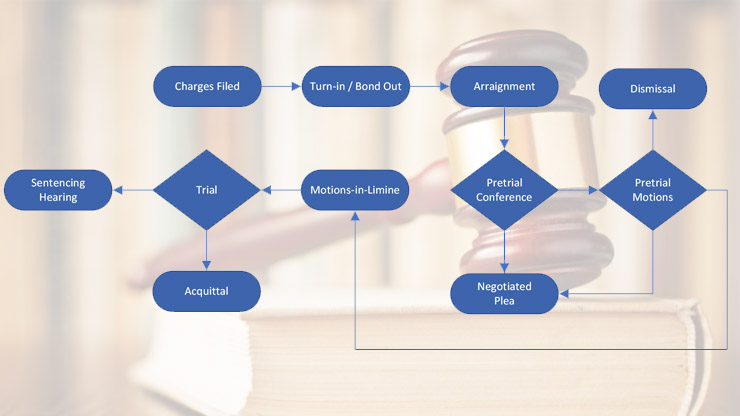
A bond is an amount of money or property given to the court as collateral to ensure that a defendant appears in court as required. When a person is arrested and taken into custody, the court will set a bail amount that must be paid in order to be released from jail prior to their trial. This amount is set based on factors such as the nature of the crime, the defendant’s criminal history, and the likelihood that they will flee. In addition to posting a certain amount of money, the court may also require additional conditions such as no contact with the alleged victim and random drug testing. For misdemeanor cases bond is usually set by the arresting officer. For felony and domestic battery cases, the bond will be set by the Judge. In Illinois, any money posted as bond will be returned to the person that posted it minus 10%, unless there are outstanding fines and costs owed to the county.
An arraignment is the first step in the criminal court process in Illinois. During an arraignment, the defendant is formally charged with a crime and informed of their constitutional rights. This includes the right to remain silent, the right to an attorney, and the right to a trial by jury. The arraignment is typically held within close proximity of an arrest. At the arraignment, the judge will ask the defendant to enter a plea, which can be either guilty or not guilty. If the defendant pleads guilty, the judge may impose a sentence at that time. If the defendant pleads not guilty, the case will proceed to a pre-trial conference where the parties will exchange discovery and negotiate possible resolutions. In Illinois, felony cases need to be indicted or have a preliminary hearing prior to arraignment. This must be accomplished within 30 days of an arrest for persons who are held in-custody, and 60 days for persons out of custody.
In Illinois courts, a pretrial conference, sometimes referred to as a status conference, is a meeting between the prosecutor, defense attorney, and judge to discuss the status of the case and any potential plea bargains. During this conference, the parties may also discuss issues related to evidence, witnesses, and the trial schedule. The purpose of the pretrial conference is to facilitate a resolution of the case, resolve any outstanding discovery issues, or schedule substantive court hearings. During the pendency of a case, there may be several pretrial conferences before the case is eventually set for trial, motion hearing, or plea.
A pretrial motion may be filed by either the prosecution or the defense in a criminal case. It is filed before the trial begins and is intended to resolve certain legal issues or procedural matters that may impact the trial. Pretrial motions can request a variety of things, such as the suppression of evidence, dismissal of charges, or a change of venue. The main purpose of pretrial motions is to streamline the trial process by resolving legal issues that may arise before the main trial begins. It allows the judge to make certain rulings before the trial starts and helps to avoid any surprises during the proceedings. Pretrial motions can also be used by the defense to suppress evidence that they believe was obtained illegally or to attempt to get charges dismissed completely.
A motion-in-limine is a pretrial motion that asks the court to make a ruling on what evidence can and cannot be presented at trial. It is filed by either party, and it is used to exclude evidence that is inadmissible, irrelevant or unfairly prejudicial. The word “limine” is a Latin term meaning “at the threshold.” The motion-in-limine is thus an attempt to draw a line at the threshold of the trial that determines what evidence is admissible and what evidence is not. The aim of the motion is to prevent unfair surprises or prejudicial evidence from being presented at trial. To file a motion-in-limine, the moving party must submit a written request to the court outlining the evidence they want excluded and their reason for doing so. The request must be filed before trial and the judge must make a ruling before the trial proceeds. The court will then schedule a hearing on the motion, during which both sides will have the opportunity to present arguments and evidence to support their position. The judge will then make a ruling on the motion, which will either grant or deny the request for exclusion.
In Illinois, there are two types of trials: a bench trial and jury trial. At either type of trial, the burden on the prosecution and the rules of evidence are the same, the only difference is who determines the question of guilt or innocence. At a Bench trial, it is a judge sitting alone that makes that determination, while at a jury trial it is 12 members of the community. At a jury trial, the verdict must be unanimous, meaning that all 12 jurors must agree. If the jury cannot agree, the case may be declared a mistrial, in which the state would have the option to retry the case. Motions-in-limine are allowed in either type of trial but are primarily used in jury trials. The theory being that jurors cannot unhear potentially inadmissible evidence whereas a judge who is a trained jurist would be able to disregard any inadmissible evidence that was presented. In Illinois, certain cases, such as ordinance violations that are punishable by fine only, are not eligible for a jury trial and if a trial is requested it must be a bench trial. If a person is entitled to a jury trial and wishes to have the matter set for a bench trial, then there must be a waiver of trial by jury. It is important to note that once a defendant has waived his or her right to trial by jury, they cannot later request a jury trial. At either type of trial, if a verdict of not guilty is returned, the defendant would no longer be subject to any bond conditions and any money posted as bond would be returned to the defendant, minus the 10% bonding fee. If a verdict of guilty is returned, the case would be set for a sentencing hearing.
A sentencing hearing in Illinois is a legal proceeding held after a criminal defendant is convicted or pleads guilty to a crime. It is customary in Illinois for a defendant to complete a pre-sentence investigation or PSI prior to the hearing that will give general information about the defendant, such as living situation, employment, and criminal history. The purpose of the hearing is for the judge to determine an appropriate sentence for the defendant based on factors such as the seriousness of the crime, the defendant’s criminal history, and any mitigating or aggravating circumstances. During a sentencing hearing, the judge will consider evidence and arguments presented by the prosecutor and the defendant’s attorney. The prosecutor may present evidence of the defendant’s criminal history, the harm caused by the crime, and any aggravating factors, such as the use of a weapon or the involvement of multiple victims. The defendant’s attorney may present mitigating evidence, such as the defendant’s lack of prior criminal history, their remorse for the offense, or evidence of rehabilitation. After considering all of the evidence and arguments presented, the judge will impose a sentence.
The majority of cases that make their way through the Illinois criminal justice system result in some type of plea. If both the prosecution and defense are in agreement to the terms of a sentence they may present that to the court for the Judge’s approval. If the judge approves the proposed disposition, then the defendant would be sentenced as agreed. If the judge denies the agreement, the parties may continue negotiations on the case and present a different plea, or the case may be set for trial. In some cases, not all of the terms are agreed to by the parties and they may present a partial plea to the court and ask the court to determine the remaining terms that are not agreed to. Sometimes the prosecution may offer a “cap plea” which means if the defendant pleas guilty, they agree to “cap” the amount of jail time they are looking for. It is important to note that judges are not bound by this cap and may impose a sentence that is greater than what the state is seeking, however, in practice this rarely happens and the judge will often give a sentence that is somewhere between the recommendations of the parties.
